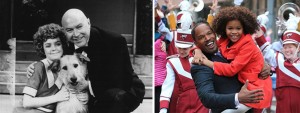The line between Broadway and Hollywood is thinner than ever, with three movie adaptations of the musicals “Jersey Boys,” “Annie” and “Into the Woods” released just this past year and a number four times that since 2000.
Indeed, the American public seems more receptive of filmmakers’ mainstream takes on popular musicals, showing that theater-lovers and cinema-lovers need no longer be mutually exclusive audiences. Not only are more musical-to-movie adaptations being made, but they are achieving comparable success to movies based on original, show tunes–free screenplays.

Perhaps the most recent and indicative example of this trend is the box office success of “Into the Woods,” 2014’s adaptation of Stephen Sondheim’s 1987 musical of the same name. Directed by Rob Marshall, “Into the Woods” has topped holiday box office charts and reigned in three Golden Globes nominations for best motion picture, supporting actress and lead actress in the musical or comedy categories, in addition to speculation of Oscars nominations.
Turning stage musicals into movies is not exactly a new 21st century development, as the practice actually dates back well into the mid-20th century. The 1960s was a particularly fruitful decade for the musical movie genre with three adaptations – “West Side Story,” “My Fair Lady” and “The Sound of Music” – winning Best Picture at the Academy Awards. Since then, stage-to-screen adaptations have only continued in an upward trend, both in terms of the number produced and in their critical reception.
One tendency that has remained fairly consistent since the inception of movie musicals is the use of actors with household names in principal roles in the films. While a casting director on Broadway may be more concerned with performers’ actual acting, singing and dancing chops than in their A-list fame, the film industry consistently leans toward building a star-studded cast over one filled with unknowns.
Take for instance the popular film adaptations “Sweeney Todd” (2007), “Mamma Mia” (2008) and “Les Miserables” (2012). Each are films filled with famous actors more closely associated with the silver screen than the Broadway stage, including Johnny Depp, Amanda Seyfried, Anne Hathaway and Meryl Streep, among others.
While famous actors are effective marketing tools to attract audiences to musical films, not all of them possess the singing abilities normally demanded on Broadway. Russell Crowe, for instance, was disappointingly raspy as Javert in “Les Miserables,” and even Meryl Streep had difficulty playing Donna convincingly in “Mamma Mia” due to lackluster vocals. Fortunately, performers in movies have the added help of studio enhancement and autotuning, transforming otherwise weak vocalists into passable singing actors.
As with any movie – musical adaptation or not – the filmmaker’s goal is accessibility and marketability. But filmmakers tasked with bringing a Broadway show to Hollywood have an extra step to consider: they have the unique challenge not only of having to honor an existing script and score, but also of making the film as appealing as possible to viewers who may not have ever been exposed to the original stage musical.

Interestingly enough, it appears that movie musicals sticking closer to the original stage versions – movies such as “Into the Woods” and “Les Miserables,” which both stayed very true to the original plots and music – tend to do better than those taking too many liberties. The recent movie adaptation of “Annie,” for instance, placed the story in modern-day Harlem instead of 1933 New York City and rearranged many of the musical’s songs for a more contemporary pop feeling. While the attempt at modernization is admirable, the film itself flopped and has thus far made $20 million less in box offices than “Into the Woods,” showing that stage musicals don’t have to be drastically updated to be relevant. In fact, it’s generally better if they aren’t.
Above all else, however, film provides a platform to bring the stories, the characters and the music of Broadway to an expanded audience. While sitting in front of a screen may not be exactly the same as sitting before a cast of live performers and instruments, it is a vehicle that has helped musicals transcend modes of entertainment.
– Emily McCormick, A&E contributor
